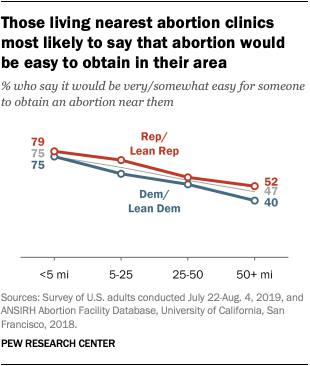
Note: For the latest data on abortion, read our 2022 report, “America’s Abortion Quandary.”
Access to clinics has become part of the long-running battle over abortion in the United States. A recent New York Times analysis shows that access to abortion clinics in many parts of the country has been decreasing in recent years.
Proximity to abortion clinics is associated with individual perceptions of how easy or difficult it is to obtain an abortion. However, partisanship is a more important factor than distance to the nearest abortion provider in shaping peoples’ views of whether an abortion should be harder or easier to obtain locally, according to a new Pew Research Center analysis of an American Trends Panel survey conducted July 22-Aug. 4, 2019.
In that survey, 33% say it should be harder for someone to obtain an abortion near them than it is currently, 26% say it should be easier and 39% say access to abortion should be about what it is currently.
Among all adults, those who live more than 5 miles from the nearest abortion clinic are more likely than those who live closer to say abortions should be harder to obtain.
Yet this difference is largely attributable to the differences in the partisan composition of these areas. Republicans and Republican-leaning independents – regardless of where they live – are far less likely than Democrats and Democratic leaners to say it should be easier to obtain an abortion in their area, and Republicans are also more likely than Democrats to live in communities that are further away from an abortion clinic.
For this analysis, we surveyed 4,175 U.S. adults in July 2019. Everyone who took part was a member of the American Trends Panel (ATP), an online panel survey that is recruited through national, random sampling of residential addresses. Recruiting our panelists by phone or mail ensures that nearly all U.S. adults have a chance of selection. This gives us confidence that any sample can represent the whole population (see our Methods 101 explainer on random sampling).
To further ensure that each survey reflects a balanced cross-section of the nation, the data is weighted to match the U.S. adult population by gender, race, ethnicity, partisan affiliation, education and other categories. Read more about the ATP’s methodology.
Respondents to the survey were geocoded to match them to the nearest abortion clinic. The abortion clinic data was obtained from Advancing New Standards in Reproductive Health (ANSIRH), a research group at the University of California, San Francisco. Distance to the nearest clinic was calculated using the spherical law of cosines to translate the latitude and longitude coordinates of panelists and abortion clinics into miles.
Here are the questions used, and the responses, for the report and its methodology.
When partisanship is taken into account, perceptions about whether abortion should be made easier or harder in their area do not vary much between people living in areas with abortion clinics and those who live a far distance from the nearest clinic. And to the modest extent that these differences in proximity do matter, those living further away from a clinic are more likely than those who live closer to say that it should be made harder to obtain an abortion in their area. An analysis controlling for other factors (age, sex, race, education and ideology) confirms this overall pattern.
For example, among Democrats and Democratic leaners, 24% of those who live 50 miles or further from an abortion clinic say it should be made more difficult to obtain an abortion near them, while only 12% of Democrats who live within 5 miles of a clinic say this. Across the board, Republicans are substantially more likely than Democrats to say it should be harder to obtain an abortion. Still, the pattern is similar among Republicans.

In contrast with opinions about abortion, people’s perceptions of difficulty or ease with which abortion can be obtained are correlated with actual distance to the nearest abortion clinic.
People who live in places with abortion clinics nearby are much more likely to say it is easy for someone in their area to obtain an abortion than those who live further away. Three-quarters of those within 5 miles of an abortion clinic say it is at least somewhat easy for someone to obtain an abortion in their area, while 47% of those who live 50 miles away from the nearest clinic say this. This pattern is similar among both Democrats and Republicans.
Note: See the questions used for this report, along with responses, and its methodology.



